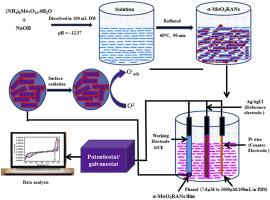当前位置:
X-MOL 学术
›
Mater. Today Chem.
›
论文详情
Our official English website, www.x-mol.net, welcomes your
feedback! (Note: you will need to create a separate account there.)
Molybdenum rods assembled with nanosheets: a high catalytic material for phenol sensing
Materials Today Chemistry ( IF 6.7 ) Pub Date : 2020-12-01 , DOI: 10.1016/j.mtchem.2020.100347 Rizwan Wahab , Farheen Khan , Naushad Ahmad , Manawwer Alam
Materials Today Chemistry ( IF 6.7 ) Pub Date : 2020-12-01 , DOI: 10.1016/j.mtchem.2020.100347 Rizwan Wahab , Farheen Khan , Naushad Ahmad , Manawwer Alam

|
Abstract The phenol (PhOH) is a toxic chemical and can affect to the environment and human directly and indirectly. Due to their toxic nature it is listed as a carcinogenic compound for human health. The sensitivity of the PhOH in liquid medium can be detemine through various techniques in liquid medium was detected through various techniques for instance HPLC, mass, fluorescence and spectrophotometry etc but all of these techniques are expensive and not easily available to detect the longer range of samples in a very less time. To keep this view the present manuscript was designed to shows the utilization of metal oxide nano and microstructures as sensor material, therefore, initially highly crystalline molybdenum oxide rods assembled with nanosheets (referred to as α-MoO3 RANs) was synthesized via solution process and utilized for sensing against PhOH. The α-MoO3RANs exhibit numerous applications in various directions such as catalyst, LEDs, Field emission devices, batteries etc. The α-MoO3RANs were formed from the solution processes in a short time span. The formed powder was well characterized through the techniques such as XRD, SEM, TEM and FTIR. From the analysis, it reveals that the size of each NS is ~200 nm in diameter whereas rods shaped structures length goes to 2–6 μm with good structural and chemical characteristics. The crystalline α-MoO3RANs were applied for the electro chemical studies as three electrode system (GCE as working electrode, Ag/AgCl as reference and pt wire as counter electrode) with PhOH as an analyte in PBS. The electrochemical studies were conducted through cyclic voltammetry (CV) in terms of their low to high conc-entration ranges from 7.8 to 1000 μM in PBS, scan rate at different potential from 5 to 100 mV with the α-MoO3RANs based working electrode (α-MoO3RANs/GCE). The designed working electrode sensor having excellent reproducibility, sustained in presence of 62.25 μM (PhOH) for seven consecutive cycles. Including this, the chronoamperometry (0–1500s) and electrochemical impedance spectra (EIS) were also analyzed. A probable mechanism was also discussed based on the analysis and their observations.
中文翻译:

纳米片组装的钼棒:苯酚传感的高催化材料
摘要 苯酚(PhOH)是一种有毒化学物质,可以直接和间接地对环境和人类产生影响。由于它们的毒性,它被列为对人类健康的致癌化合物。液体介质中 PhOH 的灵敏度可以通过各种技术来确定,液体介质中的检测可以通过各种技术,例如 HPLC、质量、荧光和分光光度法等,但所有这些技术都很昂贵,并且不容易用于检测更长范围的样品在很短的时间内。为了保持这种观点,本手稿旨在展示金属氧化物纳米和微结构作为传感器材料的利用,因此,最初用纳米片组装的高度结晶的氧化钼棒(称为 α-MoO3 RANs)是通过溶液工艺合成的,并用于检测 PhOH。α-MoO3RANs 在催化剂、LED、场发射器件、电池等各个方向上表现出众多应用。α-MoO3RANs 是在短时间内由溶液过程形成的。通过XRD、SEM、TEM和FTIR等技术对形成的粉末进行了很好的表征。从分析中可以看出,每个 NS 的大小直径约为 200 nm,而杆状结构长度为 2-6 μm,具有良好的结构和化学特性。结晶 α-MoO3RANs 作为三电极系统(GCE 作为工作电极,Ag/AgCl 作为参比,pt 线作为对电极),在 PBS 中以 PhOH 作为分析物。电化学研究是通过循环伏安法 (CV) 进行的,它们在 PBS 中的低至高浓度范围为 7.8 至 1000 μM,不同电位下的扫描速率为 5 至 100 mV,使用基于 α-MoO3RANs 的工作电极(α -MoO3RANs/GCE)。设计的工作电极传感器具有出色的重现性,可在 62.25 μM (PhOH) 存在下连续七个循环。包括这一点,还分析了计时电流法(0-1500s)和电化学阻抗谱(EIS)。还根据分析和他们的观察讨论了可能的机制。PBS 中 8 至 1000 μM,使用基于 α-MoO3RANs 的工作电极 (α-MoO3RANs/GCE) 在 5 至 100 mV 不同电位下的扫描速率。设计的工作电极传感器具有出色的重现性,可在 62.25 μM (PhOH) 存在下连续七个循环。包括这一点,还分析了计时电流法(0-1500s)和电化学阻抗谱(EIS)。还根据分析和他们的观察讨论了可能的机制。PBS 中 8 至 1000 μM,使用基于 α-MoO3RANs 的工作电极 (α-MoO3RANs/GCE) 在 5 至 100 mV 不同电位下的扫描速率。设计的工作电极传感器具有出色的重现性,可在 62.25 μM (PhOH) 存在下连续七个循环。包括这一点,还分析了计时电流法(0-1500s)和电化学阻抗谱(EIS)。还根据分析和他们的观察讨论了可能的机制。
更新日期:2020-12-01
中文翻译:

纳米片组装的钼棒:苯酚传感的高催化材料
摘要 苯酚(PhOH)是一种有毒化学物质,可以直接和间接地对环境和人类产生影响。由于它们的毒性,它被列为对人类健康的致癌化合物。液体介质中 PhOH 的灵敏度可以通过各种技术来确定,液体介质中的检测可以通过各种技术,例如 HPLC、质量、荧光和分光光度法等,但所有这些技术都很昂贵,并且不容易用于检测更长范围的样品在很短的时间内。为了保持这种观点,本手稿旨在展示金属氧化物纳米和微结构作为传感器材料的利用,因此,最初用纳米片组装的高度结晶的氧化钼棒(称为 α-MoO3 RANs)是通过溶液工艺合成的,并用于检测 PhOH。α-MoO3RANs 在催化剂、LED、场发射器件、电池等各个方向上表现出众多应用。α-MoO3RANs 是在短时间内由溶液过程形成的。通过XRD、SEM、TEM和FTIR等技术对形成的粉末进行了很好的表征。从分析中可以看出,每个 NS 的大小直径约为 200 nm,而杆状结构长度为 2-6 μm,具有良好的结构和化学特性。结晶 α-MoO3RANs 作为三电极系统(GCE 作为工作电极,Ag/AgCl 作为参比,pt 线作为对电极),在 PBS 中以 PhOH 作为分析物。电化学研究是通过循环伏安法 (CV) 进行的,它们在 PBS 中的低至高浓度范围为 7.8 至 1000 μM,不同电位下的扫描速率为 5 至 100 mV,使用基于 α-MoO3RANs 的工作电极(α -MoO3RANs/GCE)。设计的工作电极传感器具有出色的重现性,可在 62.25 μM (PhOH) 存在下连续七个循环。包括这一点,还分析了计时电流法(0-1500s)和电化学阻抗谱(EIS)。还根据分析和他们的观察讨论了可能的机制。PBS 中 8 至 1000 μM,使用基于 α-MoO3RANs 的工作电极 (α-MoO3RANs/GCE) 在 5 至 100 mV 不同电位下的扫描速率。设计的工作电极传感器具有出色的重现性,可在 62.25 μM (PhOH) 存在下连续七个循环。包括这一点,还分析了计时电流法(0-1500s)和电化学阻抗谱(EIS)。还根据分析和他们的观察讨论了可能的机制。PBS 中 8 至 1000 μM,使用基于 α-MoO3RANs 的工作电极 (α-MoO3RANs/GCE) 在 5 至 100 mV 不同电位下的扫描速率。设计的工作电极传感器具有出色的重现性,可在 62.25 μM (PhOH) 存在下连续七个循环。包括这一点,还分析了计时电流法(0-1500s)和电化学阻抗谱(EIS)。还根据分析和他们的观察讨论了可能的机制。











































 京公网安备 11010802027423号
京公网安备 11010802027423号